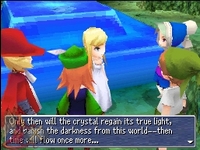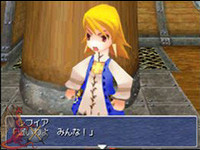|
|

|
BATTLE SYSTEM
|

|
INTERACTION
|

|
ORIGINALITY
|

|
STORY
|

|
MUSIC & SOUND
|

|
VISUALS
|

|
CHALLENGE
|
Moderately Difficult
|
COMPLETION TIME
|
30-50 Hours
|
|
OVERALL
3.0/5
|
Rating definitions
|
|
|
Final Fantasy III has been missing in action for quite some time. Initially released in Japan in 1990 for the Famicom, this game took sixteen years to make it across the ocean. Final Fantasy III is now available on the Nintendo DS as a completely remade game with a more modern look. Developers wanted to keep the experience as close to the original as possible, so much of the game is extremely similar to the Famicom version. But with the rare opportunity to fix past issues, other changes were made, such as giving the playable characters names and personalities, fine tuning job classes, and adding bonus content. With this missing link finally hitting US shores, English speaking gamers can see what they were missing out on.
The story of Final Fantasy III is fairly light. This installment features four orphans, Luneth, Arc, Refia, and Ingus, who join together in a grand adventure to save the world from darkness. The only problem is that the story never really becomes grand. Though the addition of named playable characters and a bit of backstory for each character is a nice addition, there is no real improvement in terms of story to this DS release. There is no reason to become attached to any of the game's characters, as gamers get very limited story interaction with them. With only minor plot twists, it leaves a lot to be desired. Though some story points are somewhat interesting and revealing, never will any event leave players shocked. As dull as the story can be, adding a stronger plot to appeal to newcomers would have required dramatically changing the game. That did not happen, therefore the story stays true to the original in order to give gamers the most authentic experience.
Final Fantasy III's battle system is fairly balanced, though also shows its age. In the tradition of the original NES Final Fantasy games, FFIII requires the player to input a command prior to the start of each round for each individual character. During each round, commands such as Guard or Defend will always go first with attack and magic commands following. The latter commands are affected by agility ratings, but also have some random variables factored into the equation making turn order slightly unpredictable. Characters also do not have magic points in the way that they do in more modern Final Fantasy games. Each spell has a set level and specific jobs allow for a certain number of magic points per level increasing with character level.
The job system is one of the true highlights of the game. With twenty-three jobs to encounter throughout the game, players can create many unique party combinations. Each job has its own strengths and weaknesses, so it takes time to decide which path is the best fit for the gamer. Should Luneth become a Dragoon with the ability to use the classic jump attack, or should he become a Knight with the ability to prevent those that are too weak from taking damage? Unlike the first Final Fantasy, gamers can change their characters' jobs as they please. The only penalty for changing jobs is a lowering of that character's stats for a few battles. This deters changing jobs after every battle and can hinder changing jobs in dungeons. The party setups are nearly limitless, and most jobs have been balanced to the point to where they are somewhat useful. Jobs such as the Scholar, whose ability to scan enemies was almost pointless, now has new traits such as the enhancement of items and removing beneficial effects from enemies. But some jobs have been brought down in effectiveness such as the Sage and Ninja classes. For example, the Sage is now extremely slow and the Ninja can no longer equip any weapon. These are just a few examples of the changes that have been made in order to better balance the gameplay in this release.
 Aria explains that she must "become one" with Refia in order to save the world.
Aria explains that she must "become one" with Refia in order to save the world.
| |
Along with their basic level, characters now have job levels which increase as a character performs actions in battle. The higher the job level, the more proficient a character will be at that job in terms of damage, healing power, and accuracy. Another change to the battle system is the addition of guest characters. In the original version these guests would merely follow the party around, but now they can actually assist the group in combat. Each of these guest characters have two abilities that they could potentially perform at random, such as physically attacking an enemy or healing the party. While this can be useful, it happens too infrequently to be of much assistance.
Even the most common enemies in Final Fantasy III are challenging, and bosses are just down-right tough. Gamers will need to spend a good bit of time leveling up to avoid viewing the "Game Over" screen. Saving is also quite important, as dungeons do not have save points within them; players can only save on the world map. With such tough enemies, players should save often. Another challenge is the lack of options for reviving fallen characters early on. Gamers will not have access to magic spells that restore life until at least halfway through the game. The fact that Phoenix Downs are not purchasable in stores and inns do not revive dead characters leaves the rare revival spring as the only option for most of the game. This is yet another frustration, considering how easily characters die from even causal monsters. Another disappointing element of the game is that equipment is rather limited. But a gamer willing to level a job all the way up to 99 and and who has the means to send messages via WiFi will be rewarded with a quest to obtain high-quality job specific items. WiFi is also required in starting the quest to obtain the Onion Knight job. After sending a certain number of messages through WiFi and to in-game NPCs, these quests will become available.
The user interface of Final Fantasy III is very basic. A nice feature of the interface is that gamers can select menu options using the standard DS controls or with the stylus. When purchasing weapons and armor, if a character with a certain job class can equip the item, they will be highlighted on the top DS screen. But not everything about the interface is nice. While browsing at shops, the menu shows the attack and defense rating for the weapon and armor, and on a separate area shows the character's current rating, so it does not automatically show the difference. Oftentimes, items will give other statistical increases that are not shown in the menus, meaning the only way to find out if two swords with identical attack power have any other differences is to observe the changes before and after equipping them. Another less important problem is with the WiFi message system. At a certain point in the game, players are given a code to share with others in order to send messages back and forth via the Nintendo WiFi Connection. The message input interface is very clumsy due to the fact that when entering text, the space bar is on a different menu from the letters. This makes typing a sentence quite frustrating, since gamers must change screens in between each word. Thankfully, the message feature is just an optional add-on, but it could have been better.
 You are so cute when you're angry.
You are so cute when you're angry.
| |
Graphically, Final Fantasy III is an extremely pretty game. The opening cinematic is beautiful, though it is a shame that this is the only time the player will see such cinematics. The rest of the game includes meticulously detailed character models. Each individual character has their own unique outfit depending upon what their current job is. Considering that there are four characters and twenty-three jobs, this is an impressive artistic feat. Sadly, a good number of enemies are palette swaps. With the rest of the game's visual style being of such high quality, it is a shame that so many normal enemies and bosses reuse the same graphical model. Despite that flaw, Final Fantasy III is visually impressive. It really highlights the graphical capability of the DS; however, it rarely takes advantage of both screens. While this doesn't hinder anything, it does seem like an oddity for the top DS screen to be empty for the majority of the game.
The soundtrack for the DS remake of Final Fantasy III still includes Nobuo Uematsu's original pieces. They have been remixed and arranged by fellow Black Mages band members, Tsuyoshi Sekito and Keiji Kawamori. The quality of the music is really good and most all of the pieces are pleasant to listen to, but much like the story, the music is not very memorable and offers very few standout tracks. In-game sound effects fit very well into the flow of the game, but there is nothing extraordinary about them. Overall, for a portable game, the sound quality is more than sufficient.
Final Fantasy III does not offer much originality, but this was not the aim of the developers. Wanting to keep the feel of the game as close to the sixteen year-old original version as possible, making any changes at all was not an easy undertaking. Online capability had potential for development, but instead was limited to a basic email client which didn't bring a great deal to the table. Though this title might not score high in terms of originality, many gamers will still be interested in it due to the fact that it is the first version of the game to officially make it to North America. For gamers who only wish to say that they have played every Final Fantasy game, this game gives them that opportunity. Unfortunately, this will not be enough for everyone.
Review Archives
|









